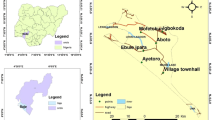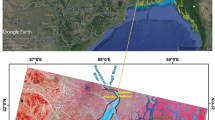Abstract
Shoreline changes have been monitored for the tropical West Coast of Maharashtra using the Survey of India (SOI) toposheet, Remote Sensing (RS) data, and its incorporation in the Geographical Information System (GIS) for the time period from 1980 to 2013. Indian Remote Sensing (IRS) Resource Sat (P6-R2) satellite data of 2013 year were geocoded using an image-to-image rectification process with the help of permanent points on the ground. The registered satellite imageries were added in Arc GIS 10.3 software with a false colour composite (FCC) band combination (3:2:1) to get clear contrast of the land–water boundary. The toposheet and satellite imagery waterlines were digitised using the line feature in Arc GIS 10.3 software. The shorelines digitised for different years were overlaid, and polygons were created for every changed location to compute shoreline changes from 1980 to 2013 to quantify the rate of erosion or accretion along the shoreline under investigation. Computed results were validated through detailed ground observations. The obtained results indicate that ~265 km (45.28%) of the coast is under erosion, ~234.17 km (40.02%) under deposition and ~85.97 km (14.70%) of the coast is stable. Maximum shoreline erosion is observed in the northern part extent from the Alibag to Shrivardhan and the deposition in the southern part of the coastal tract. The Maharashtra coast lost ~1.65 km2 net area during 1980–2013. In some places, sand spits are growing or receding in response to coastal currents and storm events. The present pattern of shoreline changes is related to physical setting of the shoreline, varying wind and wave climate and anthropogenic activity.
Research highlights
It is observed that, out of the total 585.06 km coastline studied from Alibag to Tarkarli, 264.92 km was observed under erosion, 234.17 km under deposition and 85.97 km long coastline are stable. In terms of percentage, the total length 45.28% is eroding, 40.02% is depositing and 14.70% is stable. The coast has lost a net area of about 1.65 km2 from the year 1980 to 2013 time frames. Maximum shoreline erosion is observed in the northern part extent from the Alibag to Shrivardhan and the deposition in the southern part of the coastal tract. The vulnerable and ecologically sustainable zones can be earmarked through this study for better coastal management policies.









Similar content being viewed by others
References
Agrawal D P and Guzder S J 1972 Quaternary studies on the western coast of India, preliminary observations; The Palaeobotanist 21(2) 216–222.
Aher S, Shinde S, Gawali P B, Deshmukh P and Lakshmi B V 2019 Spatio-temporal analysis and estimation of rainfall variability in and around upper Godavari River basin, India; Arab. J. Geosci. 12(22) 682.
Chandramohan P and Nayak B U 1991 Longshore sediment transport along the Indian Coast; Indian J. Mar. Sci. 20 110–114.
Chowdhury P, Behera M R and Dominic E R 2019 Wave climate projections along the Indian coast; Int. J. Climatol. 39 4531–4532.
Church J A, Clark P U, Cazenave A, Gregory J M, Jevrejeva S, Levermann A, Merrifield M A, Milne G A, Nerem R S, Nunn P D, Payne A J, Pfeffer W T, Stammer D and Unnikrishnan A S 2013 Sea level change; In: Climate Change 2013: The Physical Science Basis. Contribution of Working Group I to the Fifth Assessment Report of the Intergovernmental Panel on Climate Change (eds) Stocker T F, Qin D, Plattner G-K, Tignor M, Allen S K, Boschung J, Nauels A, Xia Y, Bex V and Midgley P M, Cambridge University Press, Cambridge, U K and New York, NY, USA, 1177p.
Deshpande G G 1998 Geology of Maharashtra; Geological Society of India, Bangalore, 223p.
Evan A T and Camargo S J 2011 A climatology of Arabian Sea cyclonic storms; J. Clim. 24(1) 140–158.
Foote B R 1876 The geological features of the south Maharatta country and adjacent districts; Geol. Surv. India Memoir 12 268.
Gawali P B, Basavaiah N and Hanamgond P T 2010 Mineral magnetic properties of sediments of beaches Redi-Vengurla coast, central west coast of India: A seasonalcharacterisation and provenance study; J. Coast. Res. 263 569–579.
Gawali P B, Aher S P, Lakshmi B V, Gaikwad R, Deendayalan K, Hanamgond P, Mahesh Babu J L V, Arote S and Bairage S 2017 Identification of landslide susceptible villages around Kalsubai region, Western Ghats of Maharashtra using geospatial techniques; J. Geol. Soc. India 90(3) 259–384.
Gujar A P, Angusamy N and Rajamanickam V 2008 Wave refraction patterns and their role in sediment redistribution along South Konkan, Maharashtra, India; Geoacta Int. J. Earth Sci. 7 69–79.
Han W, Meehl G A, Rajagopalan B, Fasullo J T, Hu Aixue, Lin J, Large W G, Wang J, Quan Xiao-Wei, Trenary L L, Wallcraft A, Shinoda T and Yeager S 2010 Patterns of Indian Ocean sea-level change in a warming climate; Nat. Geosci. 3 546–550.
Hanamgond P 2012 Dynamics of Malvan Coast, Maharashtra, West Coast, India; MoES Govt of India Major Project, MoES/11-MRDF/1/17/07/-PCIII.
Hanamgond P T and Mitra D 2008 Evolution of Malvan coast Konkan West Coast of India: A case study using remote sensing data; J. Coast. Res. 24(3) 672–678.
Hanamgond P and Mitra D 2012 Morphodyamics of Kwada and Belekeri Bay Beaches, West Coast of India: Implications from remote sensing studies; Gondwana Geol. Mag. 13 119–123.
Hashimi N H, Nigam R, Nair R R and Rajagopalan G 1995 Holocene sea level fluctuations on western India continental margin: An update; J. Geol. Soc. India 46 157–162.
Herlekar M A and Sukhtankar R K 2009 Significance of size parameters of the carbonate sands between Dabhol and Jaigarh Creek, Ratnagiri District, Maharashtra; J. Indian Assoc. Sedimentol. 28(1) 39–48.
Herlekar M A and Sukhtankar R K 2011 Morphotectonic studies along the Part of Maharashtra Coast, India; Int. J. Earth Sci. Eng. 4(2) 61–83.
Herlekar M A, Gaikwad S P, Awungshi R, Wavare N and Kamble P B 2017 Grain size analysis and characterisation of depositional environment of Holocene sediments from Kelshi to Anjarle Creek, Ratnagiri District, Maharashtra; J. Geosci. Res. 2(2) 103–114.
IPCC 2007 Climate change 2007: The Physical Science Basis. Contribution of Working Group I to the Fourth Assessment Report of the IPCC (eds) Solomon S, Qin D, Manning M, Chen Z, Marquis M, Averyt K B, Tignor M and Miller H L, Cambridge University Press, Cambridge, United Kingdom and New York, NY, USA, 996p.
Iyer L A N 1939 Geology of south Ratnagiri districts; Rec. Geol. Surv. India 74 504–529.
Joseph A, Prabhudesai R G, Mehra P, Vijay Kumar, Agarwadekar Y, Luis R, Rivankar P and Viegas B 2010 November 2009 tropical cyclone Phyan in the eastern Arabian Sea: Oceanic response along west India coast and Kavaratti lagoon; https://doi.org/10.1109/OCEANSSYD.2010.5603802.
Kale V S and Rajaguru S N 1985 Neogene and Quaternary transgressional and regressional history of the west coast of India – An overview; Bull. Deccan College Res. Inst. 44 153–165.
Kale V S, Kshirsagar A A and Rajaguru S N 1984 Late Pleistocene Beach rock from Uran, Maharashtra, India; Curr. Sci. 53 317–319.
Mahapatra M 2015 Cyclone hazard proneness of districts of India; J. Earth Syst. Sci. 124(3) 515–526.
Misra A and Balaji R 2015 A study on the shoreline changes and land-use/land-cover along the South Gujarat coastline; 8th International Conference on Asian and Pacific Coasts (APAC); Proc. Eng. 116 381–389.
Mitchell C and Widdowson M 1991 A geological map of the southern Deccan Traps, India and its structural Implications; J. Geol. Soc. Lond. 148 495–505.
Nayak S 2000 Critical issues in coastal zone management and role of remote sensing; In: Subtle issues in Coastal Management, Dehradun, India (eds) Sudarshana R, Mitra D, Mistral A K, Roy P S and Rao D P, Indian Institute of Remote Sensing, pp. 75–98.
Powar K B 1993 Geomorphological evolution of Konkan coastal belt and adjoining Sahyadri uplands with reference to Quaternary uplift; Curr. Sci. 64 793–796.
Rajamanickam G V, Vedamony P and Gujar A R 1986 Effects of waves in the redistribution of sediments along the Konkan coast; Proc. Ind. Acad. Sci. 95 223–244.
Rajawat A S, Chauhan H B, Ratheesh R, Rode S, Bhanderi R J, Mahapatra M, Mohit Kumar R, Yadav S P, Abraham S S, Singh K N and Keshri A 2015 Assessment of coastal erosion along the Indian coast on 1:25,000 scale using satellite data of 1989–1991 and 2004–2006 time frames; Curr. Sci. 109(2) 347–354.
Sanil Kumar V, Pathak K C, Pednekar P, Raju N S N and Gowthaman R 2006 Coastal processes along the Indian coastline; Curr. Sci. 91(4) 530–536.
Sarkar P K and Soman G R 2010 Environment of deposition of the Meatconglomerate-Quartzite Sequence (Equivalent of Basal Member of Bababudan Group) along the Malvan coast, Sindhudurg District, Maharashtra, India; Origin and Evolution of the Deep Continental Crust; Narosa Publishing House Pvt. Ltd., New Delhi, India, pp. 33–41.
Shaji C, Kar S K and Vishal T 2014 Storm surge studies in the North Indian Ocean: A review; Indian J. Mar. Sci. 43(2) 125–147.
Simm J D, Brampton A H, Beech N W and Brooke J S 1996 Beach management manual: London, Construction Industry Research and Information Association (CIRIA) Report 153 448.
Subbarao K V and Hooper P R 1988 Reconnaissance map of the Deccan Basalt Group in the Western Ghats, India; In: Deccan Flood Basalts (ed.) Subbarao K V, Geol. Soc. India Memoir 10 393.
Sukhtankar R K 1995 An evolutionary model based on geomorphic & tectonic characteristics of the Maharashtra coast, India; Quat. Int. 26 131–137.
Unnikrishnan A S, Nidheesh A G and Lengaigne M 2015 Sea-level-rise trends off the Indian coasts during the last two decades; Curr. Sci. 108(5) 966–971.
Wagle B G 1989 Morphology and evolution of the central West coast of India; Mahasagar 22(1) 13–21.
Widdowson M and Cox K G 1996 Uplift and erosional history of the Deccan Traps India: Evidence from laterites and drainage patterns of the Western Ghats and Konkan coast; Earth Planet Sci. Lett. 137 57–69.
Yang S, Dong L and Xiyong H 2020 Characteristics of mainland coastline changes in southeast Asia during the 21st century; J. Coast. Res. 36(2) 261–275.
Acknowledgements
The financial support received from ISRO-Cell, Savitribai Phule Pune University (Project No. GOI-A-337(B) 129), Government of India is thankfully acknowledged. Thanks are due to the reviewer for his critical review and valuable suggestions. The authors (MAH and PBK) are thankful to the Head, Department of Geology, Savitribai Phule Pune University, Pune for extending all the facilities.
Author information
Authors and Affiliations
Contributions
Milind A Herlekar: Investigation, conceptualisation, supervision, writing an original draft, visualisation, fieldwork. Prafull B Kamble: Formal analysis, data curation, methodology, validation, fieldwork. Praveen B Gawali: Data acquisition, manuscript writing, and editing. Pramod T Hanamgond: Scientific input. Sainath Aher: Analysis of GIS data, software analysis.
Corresponding author
Additional information
Communicated by Maripi Dileep
Rights and permissions
About this article
Cite this article
Herlekar, M.A., Kamble, P.B., Gawali, P.B. et al. Quantitative assessment of shoreline changes along the tropical West Coast, Maharashtra, India: A remote sensing and GIS approach. J Earth Syst Sci 132, 31 (2023). https://doi.org/10.1007/s12040-023-02047-8
Received:
Revised:
Accepted:
Published:
DOI: https://doi.org/10.1007/s12040-023-02047-8




